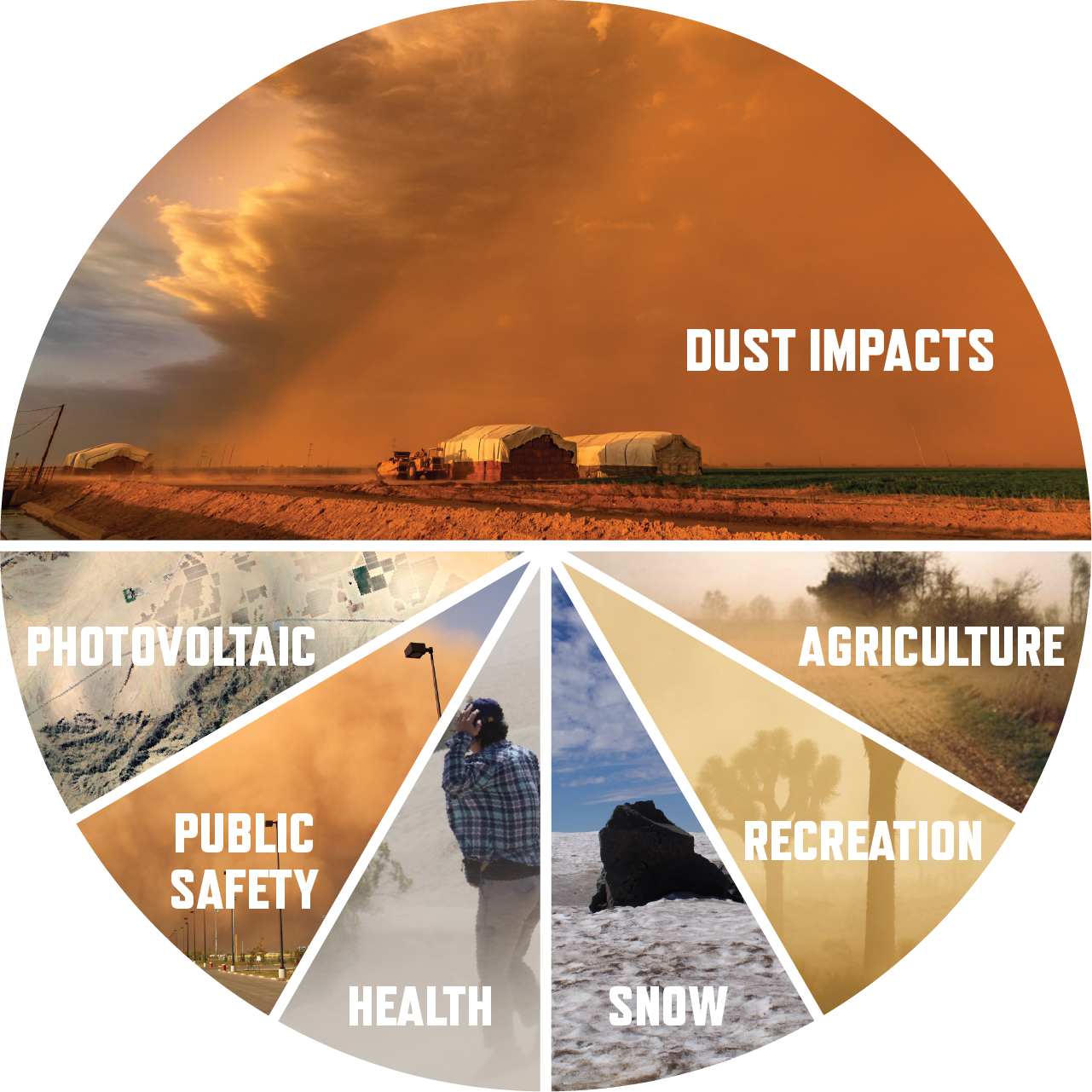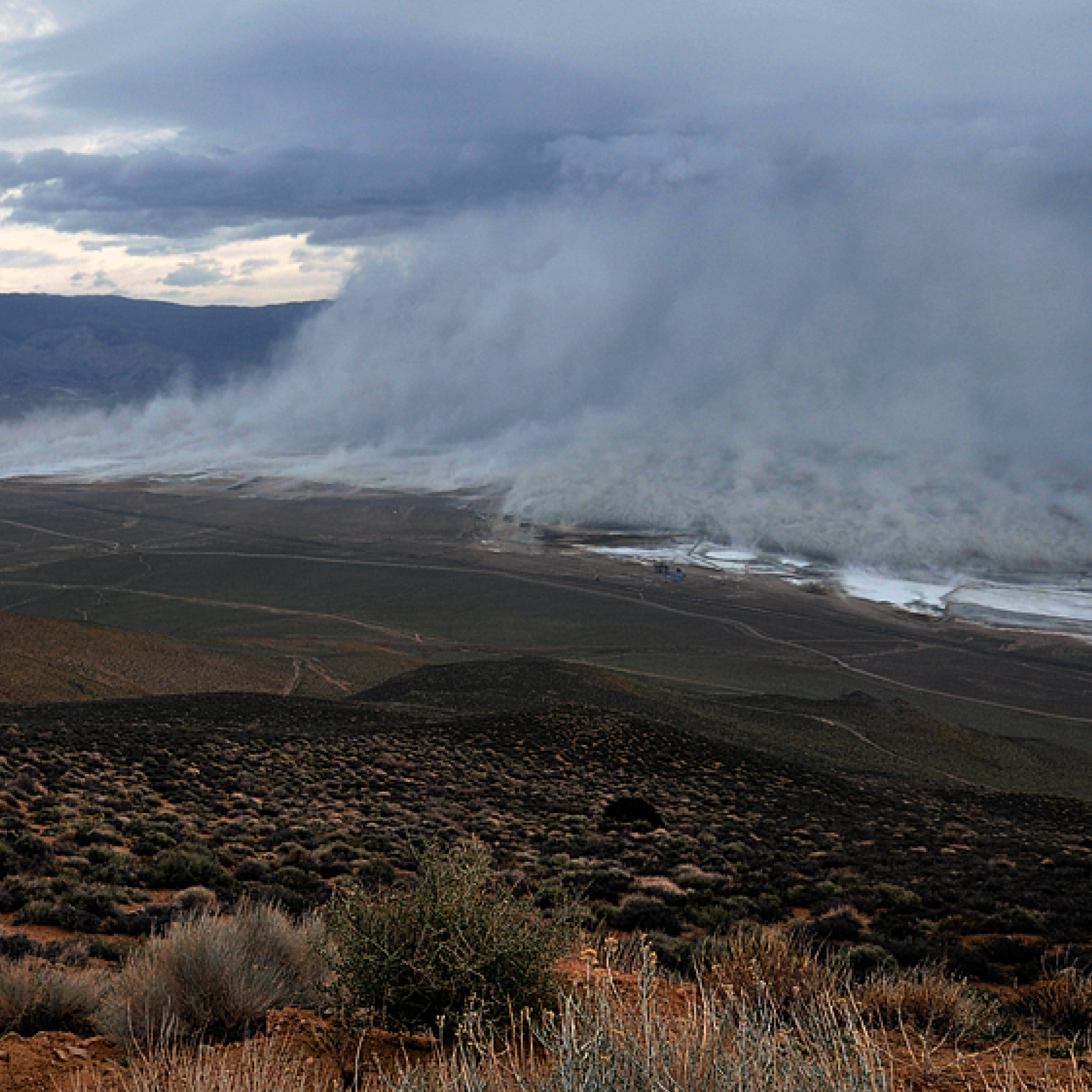

Broad Impacts
Dust storms create a range of hazards with far-reaching social and economic implications for California and its residents. These include impacts of dust on the environmental services that support the state, like water and agriculture, and on the state’s expanding solar photovoltaic infrastructure which provides energy services to millions. More directly, dust storms create acute public safety hazards through reduced visibility, lead to reduced recreation and other avoidance behaviors that can have important economic and welfare consequences, and – most important – pose direct threats to human health through both inhalation of the particles themselves and increased exposure to toxins or pathogens that are lofted into the air along with soil particles. Here we discuss these dust impacts as a first step towards quantifying the damages attributable to dust in California. This type of estimate forms the backbone of standard benefit-cost analyses, enabling policymakers to decide how to optimally deploy mitigation resources for maximum benefit.
Direct Effects of Dust
Human Health
Airborne dust is transported over long distances and contributes to adverse health outcomes for populations near and far from its sources (Morman and Plumlee, 2013). Inhaled dust poses a significant health risk, as fine particulate matter penetrates deep into the lungs, and the smallest particles, those having diameter less than 2.5 microns, can enter the bloodstream, causing oxidative stress, inflammation, and immune response issues (Fussell and Kelly, 2021; Lwin et al., 2023; Tong et al., 2023). Epidemiological evidence links dust exposure to respiratory illness (e.g., difficulty breathing, coughing, decreased lung function, exacerbated asthma, chronic obstructive pulmonary disease) and cardiovascular disease (e.g., heart attacks, strokes) (Johnston et al., 2019; Jones and Fleck, 2020; Kanatani et al., 2010; Khammar et al., 2023; Lwin et al., 2023). Dust may also contribute to allergic and atopic conditions, including eye diseases, by acting as an allergic adjuvant and enhancing allergic responses (Khammar et al., 2023; Lwin et al., 2023). Emerging research also associates dust exposure with adverse birth outcomes, potentially affecting infant health and development and contributing to increased infant mortality risk (Altindag et al., 2017; Heft-Neal et al., 2020; Jones, 2020; Kanatani et al., 2014; Moreira et al., 2020; Viel et al., 2020). It is important to note that a majority of studies linking dust exposure to adverse health outcomes have used data from populations in Asia, Africa, and Europe, with few studies focusing on US or California populations. Epidemiological studies in California are needed to clarify the relevant health impacts of dust and identify the highest risk communities.
A key worry in California is that dust often contains more than geogenic minerals. Dust – particularly from sources heavily impacted by human activity – often carries chemicals, including neurotoxic pesticides and heavy metals like lead, arsenic, and cadmium, that can lead to chronic toxicity, endocrine disruption, and increased cancer risks. These contaminants can accumulate in the body, affecting neurological development, immune function, kidney health, and blood cell production. In addition to metals, dust can carry biologic species (fungi, bacteria, viruses) that directly cause illness or lead to enhanced inflammatory responses that increase the risk of pulmonary disease. In California (and across similar climates in the U.S. and Mexico), dust exposures drive incidence of coccidioidomycosis (Valley Fever). This infection is caused by inhaling dust containing the fungi Coccidioides spp. Although the majority of symptomatic cases resolve for individuals with robust immune systems, symptoms may last for many months. Moreover, 5-10% of cases will develop chronic pulmonary disease and 1-4% develop disseminated disease, the most severe outcome that is characterized by the infection spreading to other organs of the body such as the nervous or skeletal systems . Incidence of Valley Fever is on the rise in California, and more regions are expected to become endemic under changing climate.
The Environmental Protection Agency (Region 9) has been working in California to identify the health risks associated with the distribution of naturally occurring asbestos (NOA) that are easily suspended in the air as dust. Asbestos is a known human carcinogen that causes cancers in the lungs and lining of internal organs in addition to asbestosis and respiratory diseases that constrain lung function. NOA occurs as long, thin, separable fibers derived from asbestiform minerals in rocks and soil formed through natural geological processes in the coastal ranges and foothills of the Sierra Nevada mountains. The subsequent mining of NOA throughout California has exacerbated the human-induced disturbance of NOA-containing soils and rocks, but the full range of NOA distribution and associated human health effects remain underrecognized.
Public safety
Beyond direct and mediated health impacts, dust is also an important contributor to broader public safety concerns in California (Tong et al., 2023). Airborne dust poses a significant risk to transportation safety by impairing visibility on highways and thereby increasing the risk of car accidents (Li et al., 2018; Van Pelt et al., 2020). National Highway Traffic Safety Administration (NHTSA) records from 1994-2011 indicate that dust / blowing sand, soil or dirt contributed to 17% of weather-related U.S. highway fatalities (which were themselves around 17% of total traffic fatalities) (Ashley et al., 2015).
In California, researchers linked public transportation incident records (from the Statewide Integrated Traffic Records System, SWITRS) with data on weather and visibility, and satellite observations of aerosol optical depth, and found that wind-related weather accidents have double the fatality rate of other weather related accidents, and are associated with low visibility and high dust optical depth, pointing to dust as a major contributor to road travel risk (Bhattachan et al., 2019). Literature exploring the relationship between dust and aviation or sea travel is more sparse, but reviews of aviation reports have revealed dust devils as a source of equipment damage (Baddock et al., 2013; Lorenz and Myers, 2005).
Recreation
Recreation, opportunities for adventure, and enjoyment in the natural environment can sometimes be disrupted by atmospheric dust through its impacts on both the environment and the individuals engaging in recreational activities.. The potential impacts on recreation vary depending on the amount of dust, its composition and the specific recreational activity involved. Exposure to airborne dust can have a range of effects, from irritation of the eyes, nose, and throat, to more severe consequences, such as the exacerbation of respiratory conditions. Inhaling dust can lead to a range of respiratory symptoms that diminish the enjoyment of recreational activities like hiking, biking, or picnicking, and individuals are less inclined to spend time in recreational activities when high concentrations of PM10 are present. In addition to health impacts, anthropogenic dust emissions also have broader environmental repercussions that affect the overall recreational experience by disrupting the natural beauty of recreational landscapes. Haze from airborne dust can significantly reduce visibility, obstructing scenic vistas and natural landscapes, thereby detracting from the aesthetic appeal of outdoor recreational areas Furthermore, particle pollution of water bodies can carry contaminants in aquatic environments, compromising water quality and diminishing opportunities for recreational activities like fishing or swimming.

Indirect effects of dust on ecosystem services
Snowpack
Mountain snowpack is a critical resource in the western US for the supply of freshwater to irrigation, urban areas, and industrial developments. Despite recent years exhibiting record snow in the Sierra Nevadas (e.g. winter 2022/2023) there is a long-term decreasing trend in snowpack across the state. One factor affecting the amount of mountain snowpack is the deposition of dust. Dust settling on snow surfaces influences a range of environmental processes and systems. From altering albedo to affecting the water balance, dust plays a role in shaping natural ecosystems and human environments. Snow presents the highest albedo of any natural surface, but the presence of impurities like dust decreases snow albedo, especially in the visible wavelengths, thereby increasing absorption of solar energy. This darkening effect of dust accelerates snowmelt, altering the montane hydrological cycles and regional energy balances . Moreover, snowmelt acceleration reduces the natural storage of winter precipitation in snowpack with important socioeconomic implications for regions reliant on snowmelt for agriculture, hydropower generation, and municipal water supplies. In the case of California, snowmelt plays a crucial role in sustaining water availability during the rainless months of the growing season. Changes in the timing of snowmelt also disrupt ecosystems that rely on consistent water availability, change plant phenology, control forest fire regimes, alter wildlife habitat suitability, species migration, and biogeochemical cycling, with important impacts on species distributions, community composition, biodiversity and ecosystem functioning and services.
Agriculture
California is the nation’s largest agricultural producer, growing nearly 100% of some of the country’s most treasured fruit and nut crops, and serving the state, country, and beyond with its vegetable and dairy production. In addition to agricultural activities enhancing dust emissions (see above), dust itself has myriad impacts on the agricultural sector. Dust storms can directly cause physical damage to plants, and dust deposition on leaves negatively impacts photosynthesis, including by blocking chlorophyll from absorbing incoming radiation. Even in the absence of direct damage or dust deposition, suspended dust leads to reduced crop yields as reduced downward solar radiation leads to reduced photosynthesis, which is not offset by any benefits from increased scattered light use efficiency, or surface temperature impacts Beyond crops, dust storms can injure and kill livestock, resulting in asset as well as income loss for producers. Moreover, the health impacts of dust exposure are more acute for the agricultural labor force who work outdoors. Furthermore, even at low levels of ambient pollution small changes in PM exposure are associated with decreases in agricultural labor productivity, suggesting that small dust events may exert a negative impact on California’s economy.
Photovoltaic systems
Solar energy systems have experienced a notable rise in recent decades thanks to a combination of technological advancements, reduced costs, and increased awareness of environmental concerns. In the United States alone the U.S. Energy Information Administration has forecasted a 75% increase in solar power generation from 2024–2026. Many of these installations are situated in arid regions, as they are particularly suitable for solar energy production mainly due to intense sunlight, clear skies, and availability of unused land.
In recent years there has been a growing interest in understanding the potential impacts of dust settling onto these energy systems. Wind tunnel experiments and field data have demonstrated that dust deposition onto photovoltaic (PV) panels reduces cell performance. Laboratory studies have demonstrated that the reduction in PV output efficiency is approximately proportional to the dust mass deposition, with modeling and observational work suggesting that the reduction in efficiency can be as high as 25%. Measurements at a large commercial site suggest that even when averaged over long time periods, PV output in areas where dust storms occur can be reduced by approximately 10% due to deposition. Addressing dust deposition requires regular maintenance and cleaning of panels with water , which is typically limited in these arid environments. Furthermore, the water requirements to address dust deposition onto PV panels may be so large that alternative forms of energy production, like biofuels, may be equally feasible in arid regions.
Environmental justice
Dust impacts are not felt evenly across the population of California. Sources (e.g., exposed playa of the Salton Sea and Owens Lake, or fallow farmland in the Imperial and San Joaquin Valleys) tend to be more proximate to lower-income communities, communities with higher Hispanic/Latino population shares, and greater fractions of undocumented immigrants (US Census Bureau, 2023). This is reflected in increased asthma aggravations nearby: for example, Imperial County has the highest rate of pediatric asthma hospitalization in the state, and unlike other regions,


